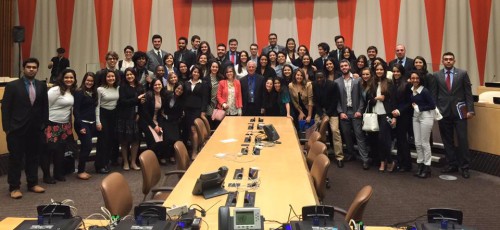
Last week, KFC and I attended the 2015 UN Department of Public Information Model United Nations Workshop. Like past workshops run by UNDPI on Model UN, the goal of the workshop was to educate Model UN leaders, conference organizers, and teachers from around the world about how the UN actually functions and encourage conferences to adopt the UN4MUN Model for Model UN. To see how UN4MUN applies to Model UN in General Assembly committees, check out our recap of the 2013 UN4MUN Workshop.
This year, the workshop covered an entirely new area for UN4MUN- the United Nations Security Council, and how MUN conferences can accurately simulate it. Let’s dive in-depth to talk about how the UNSC actually works, and how Model UN conferences can get closer to an accurate simulation of it.
Structure of the UNSC

In this picture, the Director of the Security Council Affairs Division Mr. Mosves Abelian advises the President of the UN Security Council at the time, Gabon.
There are 15 Member States of the UNSC, split into two groups:
- The P5- 5 Permanent Members of the UNSC who hold veto power over UNSC resolutions, specifically the UK, USA, France, China, and Russia
- The E10- 10 Elected Members of the UNSC, chosen from the different UN regional groups to serve 2-year terms.
The UN Security Council is chaired by a rotating presidency- each month, the presidency rotates alphabetically among the Security Council Members. There have historically only been a few exceptions to this- when states have changed the name of their country (when Upper Volta changed its name to Burkina Faso, it had the presidency twice in 3 months), or when Rwanda was up for the Presidency during the Rwandan genocide (the Security Council decided to skip Rwanda in the rotation). The President of the Security Council can make statements on behalf of the Council, as well as on behalf of their Member State, by indicating the transition to those present.
In UN4MUN, the Security Council is chaired by the delegates representing the current President of the Security Council. The President is assisted by a member of the UN Secretariat, specifically the Director of the Security Council Affairs Division, who trains the President on how to run meetings and guides them throughout the simulation.
Types of Security Council Meetings
Informal Consultations of the Whole- At the beginning of UNSC Sessions, the Council will come together for “Informal Consultations of the Whole”, a session without specific procedures, to find consensus on the President’s draft agenda. The main types of meetings included in this agenda are listed below:
Public Meetings of the UN Security Council
- Open Debate- Open discussion of the agenda items between Members of the UNSC and other invited Member States interested in discussing the agenda item
- Debate- Open discussion of the agenda items between Members of the UNSC and Member States directly involved with the agenda item
- Briefing- Members of the UN Secretariat and other experts may be invited to brief the Security Council on the agenda item, followed by statements from Member States
- Adoption- Member States will either adopt or reject Draft Resolutions brought before the Council
Private Meetings of the UN Security Council (not press or public records)
- Private Meeting- Discussions involve Members of the UNSC and non-Members where no public record is kept and no press is permitted
- TCC Meeting- Troop Contributing Countries meetings involve the UNSC and all Member States contributing troop or police forces to UNSC missions to discuss logistics, brief Member States on what their forces will be doing and coordinate expectations and standards
Informal Meetings of the UN Security Council (not official meetings)
- Informal Consultations of the Whole- Used to set the agenda for meetings, but also as an “informal informal” session to draft resolutions and lobby for support among the members of the committee.
- Informal Dialogue- Similar to Private Meetings, however not conducted in official UNSC meeting rooms and no record is made
- Arria-Formula Meetings- Initiated by non-President Members of the UNSC by invitation-only, where attendance is optional. UN Secretariat is not involved except for translation, and no record is kept. Is not held in any official UNSC chamber
The UNSC navigates these meetings to eventually produce several types of documents, not just resolutions!
Types of UNSC Documents
Rather than just drafting resolutions, the UNSC actually produces several types of documents:
- Press Elements- A few paragraphs agreed upon by the Council so that the President can speak to the Press on a brief agreed summary of Council discussions. Usually agreed upon by consensus.
- Press Statement- A Press Release from the committee discussing the work of the committee and sometimes including substance that is being agreed upon by the committee. Begins with “The Security Council”
- Presidential Statements- Rather than taking action like a resolution, a Presidential Statement allows the body to state their policies on the matter. Usually passes by consensus, however Member States may choose to disassociate from the Presidential Statement
- Communiques- At the end of each private meeting, the UNSC releases a “Communique” to give the public a general idea of who was at the meeting and what was discussed
- Resolutions- Formal Action taken by the UNSC on the agenda item which can create international law, authorize Peacekeeping Operations, state policy, or dictate actions by the UN on the topic.
Once the committee has completed it’s work on an agenda item, it will usually vote on a resolution. About 90% of UNSC resolutions are unanimous, but a few times a year a resolution will be vetoed or a member of the Security Council will abstain from voting. Almost no resolutions that make it to a vote fail without a veto power stopping them. Once a resolution is passed, it is set to be implemented by the international community, Member States, and UN Secretariat!
For more information about how the UNSC works, check out the UNSC Working Methods handbook!

